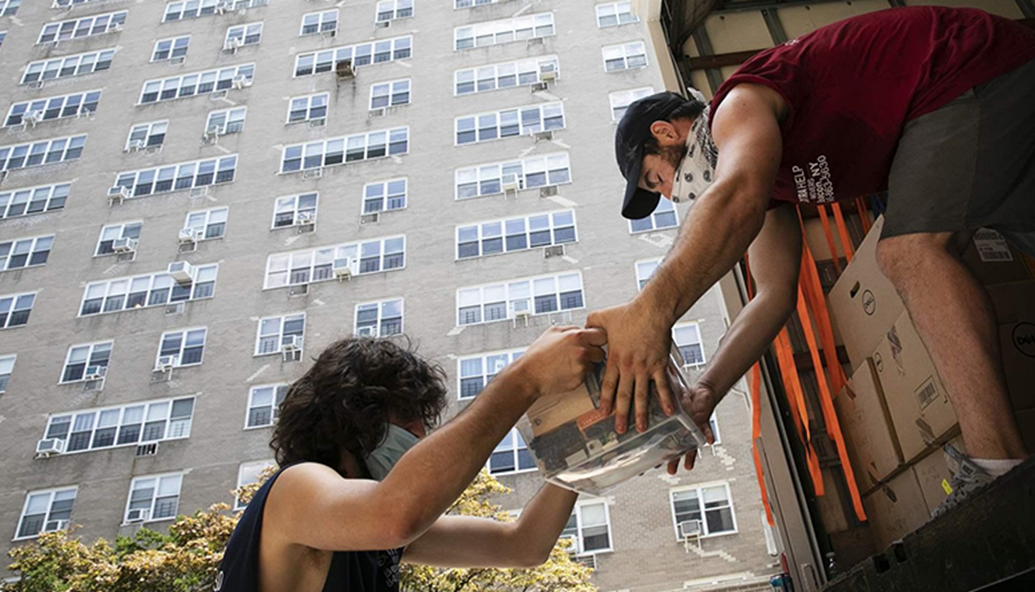March 24, 2022 The Pandemic Prompted People to Move, But Many Didn’t Go Far

Full story here
The annual Halloween party last year was a revelation for locals in Orcas Island, Washington, a scenic rural spot 100 miles north of Seattle.
“For the first time in the 10 years we’ve lived here, we didn’t recognize about two-thirds of the families,” said Edee Kulper, a photographer who blogs about life on the island. “It was startling. There’s been such a quiet influx. One of the local schools has had to build an additional classroom to accommodate new families.”
In the year after the COVID-19 pandemic began in March 2020, moves out of city centers increased from the year before, as did moves into rural and suburban areas, according to a Stateline analysis of postal change-of-address forms. But the trend slowed considerably during the second year of the pandemic.
Moves out of the densest parts of big cities, those with more than 10,000 people per square mile, jumped 17% to about 2.9 million during the first year of the pandemic, from March 2020 to February 2021, according to the analysis. The number of moves out of those dense areas returned to pre-pandemic levels in the following year, March 2021 to February 2022.
Some areas of Florida, North Carolina, South Carolina and Texas swelled with out-of-state movers who left shutdown coastal cities in search of roomier, cheaper Sun Belt homes. However, many people who moved out of cities just headed for nearby suburbs within their state.
People kept moving to big metro areas during the pandemic but tended to favor more residential areas of the cities and big suburbs, said Stephan Whitaker, a policy economist at the Federal Reserve Bank of Cleveland who has studied pandemic moves using consumer surveys.
“It’s a very strong phenomenon right now, staying within the metro area but moving to a suburban neighborhood rather than central, dense neighborhoods,” Whitaker said.
The pandemic may have sped up a change already in the making, he added, as millennials reach middle age and look for more space to raise families. He also noted that commuting has become less of an issue as more employers allow remote work.
Fast Moves
Many movers acted fast when COVID-19 struck: Permanent moves nationwide jumped 15% in March 2020, compared with the same month in 2019, according to the Postal Service numbers. The change-of-address forms don’t capture all moves, since not everybody files a form, but experts say they accurately reflect broader trends.
In that first month alone, according to the forms, net moves out of Brooklyn, Chicago and Los Angeles more than doubled, and moves out of San Francisco were up 68% from the previous month. Net moves out of Manhattan more than tripled that month to 6,400, and would surpass 13,000 by June, according to lists compiled by Stefan Rayer, director of the population program at the state Bureau of Economic and Business Research at the University of Florida.
During the first year of the pandemic, more people moved out of Seattle than moved in, peaking at a 3,400 net loss in August 2020, Rayer found. Orcas Island gained 100 new residents over the course of the year, according to Stateline’s analysis.
Similar shifts played out in other states. In Illinois, moves to suburban Winnetka, 22 miles from Chicago, almost doubled as net moves out of Chicago spiked from 2,000 monthly before the pandemic to more than 6,000 per month in August 2020, according to the CBRE Group, a real estate service firm.
In Texas, moves out of Houston increased 62% in the first month of the pandemic, according to Rayer, while a western suburb, Katy, attracted more movers than any other area in the country.
“People figured if they were going to be cooped up for the duration of this thing they might as well have a little more space and a yard,” said Chuck Martinez, president of the Katy Area Economic Development Corporation.
Rural and suburban areas within big metro areas were especially likely to attract new movers, including individuals, families and businesses.
The Katy area, a sprawling, mostly unincorporated network of planned communities along major highways west of Houston, is more expensive than Houston but offers roomier homes and lots. Rice University’s Kinder Institute for Urban Research studied change of address data in the area and concluded that Houston may have lost thousands of residents to places like Katy during the pandemic.
Sun Belt areas with new housing developments had some of the biggest ratios of people moving in compared with people moving out, said Nadia Evangelou, a senior economist for the National Association of Realtors, who analyzed the change-of-address data for 2021.
In that year, Florida’s inbound moves were 34% higher than inbound moves on average, with similar gains in Texas, Arizona, South Carolina and North Carolina. Home prices have increased more than 40% since the pandemic in parts of those states, she said, but they’re still more affordable for remote workers than major coastal cities.
In some parts of northern Florida—Daytona and Crestview in the panhandle, and Clay County near Jacksonville—two people moved in for every person who moved out, she said.
Clay County benefits from a new expressway under construction that will link outer Jacksonville suburbs and I-95, said Laura Pavlus, vice president of the county’s Economic Development Corporation.
There also was new appeal to rural places such as Orcas Island and Viola, Arkansas, where movers added to populations that had been shrinking.
“I get people calling all the time, especially people with kids saying they want to get their kids into a smaller school,” says Viola School District Superintendent John May. “I think people get tired of all the chaos in the big cities. We just don’t have that many places for them to live. We’re very rural.”
Viola, in rural Fulton County, has only 358 people but gained 81 net movers in the pandemic’s first year, according to Stateline research. Both Viola and Orcas Island are in areas classified as extremely rural by the U.S. Department of Agriculture.
A Return to Cities?
Young adults will still want to move to cities, and rents may get more reasonable as the larger millennial generation moves out, Whitaker said.
“Those [younger] people will continue to come in,” Whitaker said. “They might not have to pay as much as people did a few years back. Rents might not appreciate as quickly.”
New York City and San Francisco have been slowest to recover pre-pandemic moving patterns, said Richard Barkham, head of Americas Research for the CBRE Group, possibly because they’re so expensive and dependent on public transportation, which people were hesitant to use in the pandemic.
CBRE analyzed the change-of-address data last year and found signs that people tended to move to counties near big cities, especially affluent young adults who are childless and can work remotely.
However, those trends may be coming to an end, Barkham said, citing stronger-than-expected demand for rental apartments in urban areas. Even New York City and San Francisco could start getting more movers again later this year.
“We were quite surprised by the strength of rentals, especially in Boston and New York,” Barkham said. “People are signing leases, and they’re paying more for them. So, these trends may be reversing themselves.
“I don’t think it’s necessarily people moving back,” he said. “It might be a new generation graduating from college and going to work.”
